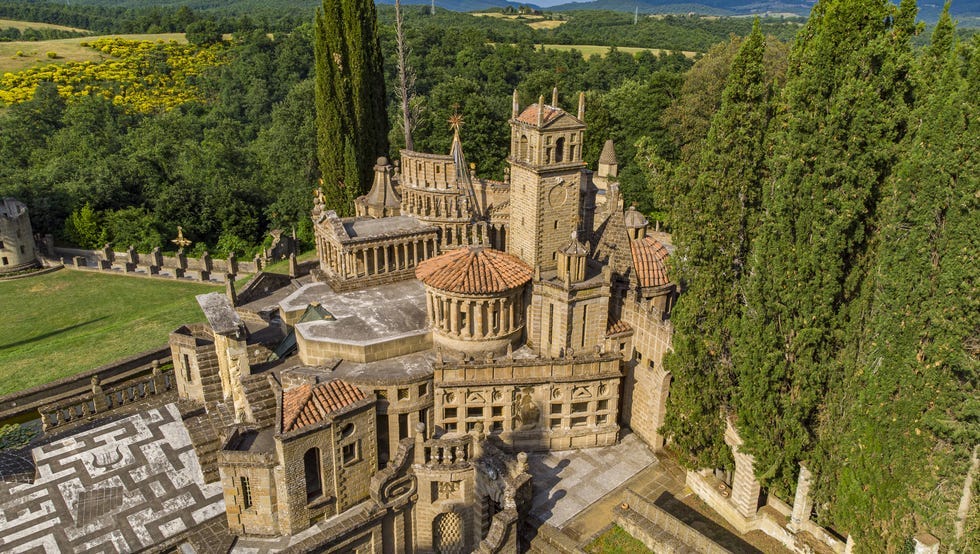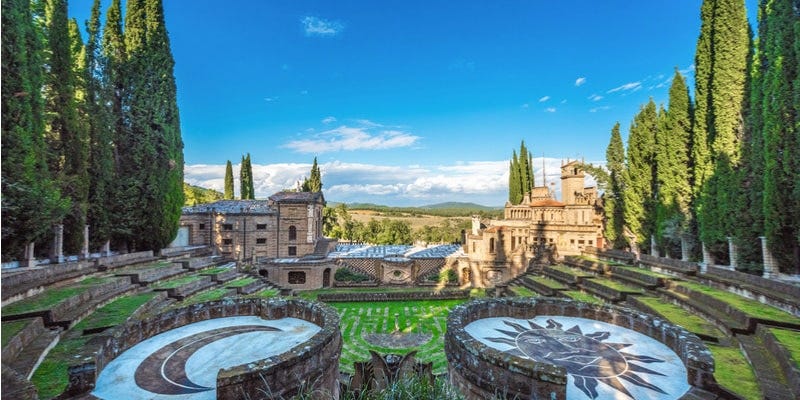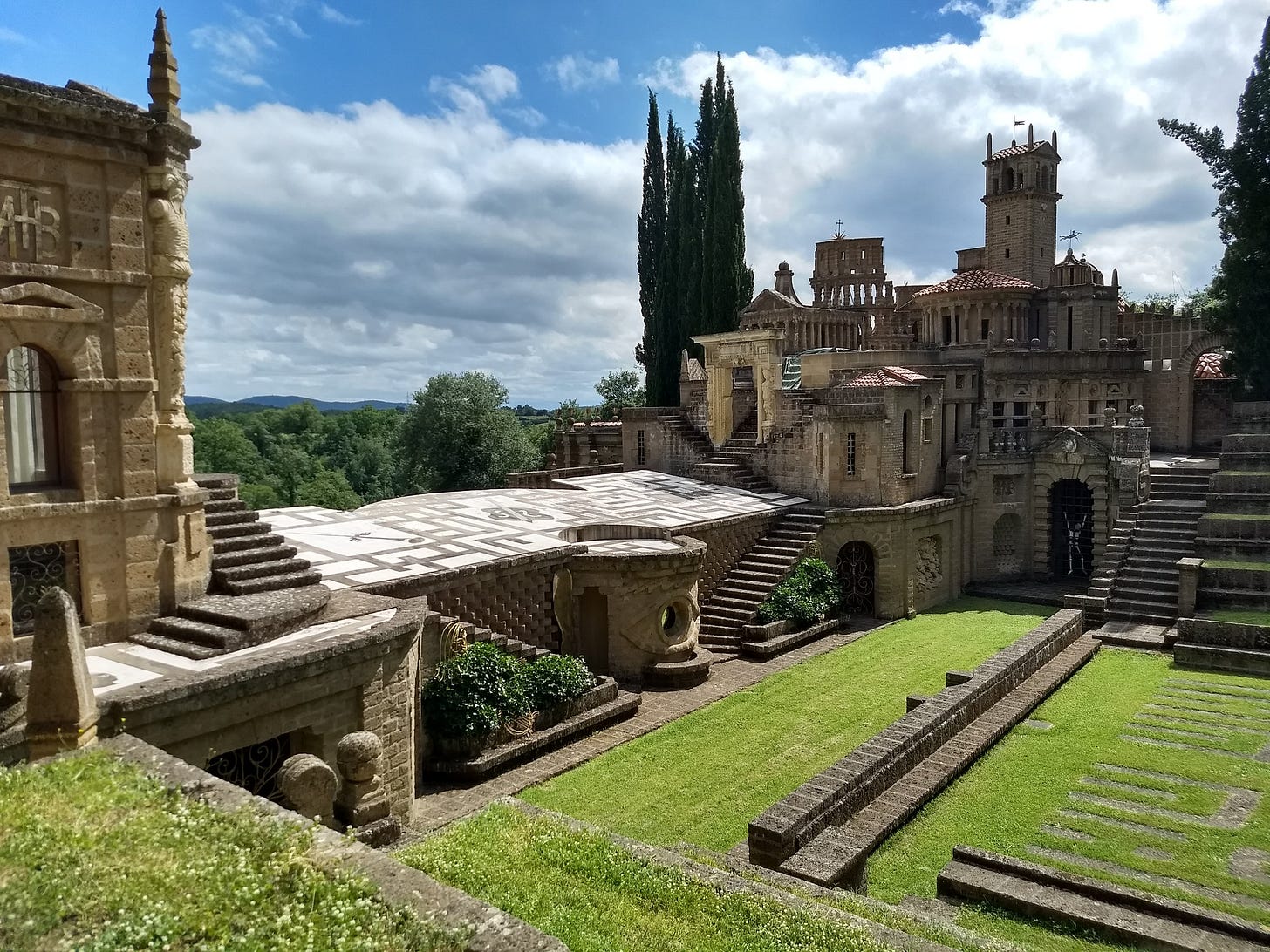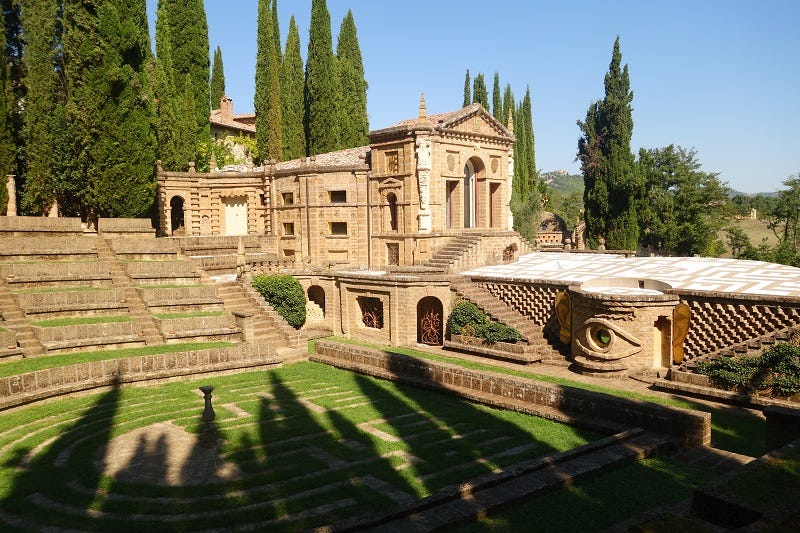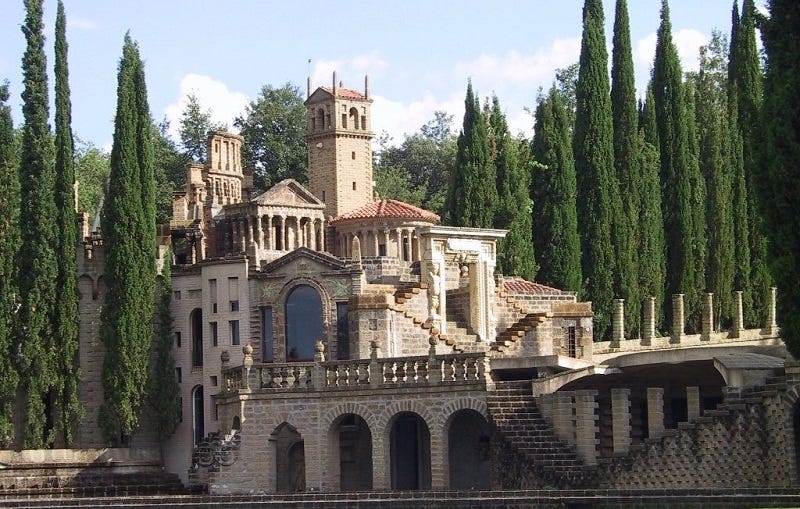Cities and Culture: Part 2 of 3
How the sacred and the profane meet in one man's folly—the 'ideal city,' an adults-only playground in Umbria is a journey within the journey.
A mini-series for supporters. If you’re interested in the topic of culture and cities, consider becoming a supporter. This 3-part mini-series will run in the next couple of weeks.
Part 1 is an overall review of the innovations that cities brought to the 12th and 13th century, creating the context that led to the Renaissance.
Part 2 will be a travel through time in a place that exists outside time, an ‘ideal city’ built to measure a man with his own mortality.
In part 3 we take a tour of a few ‘ghost towns,’ places where once humanity thrived and now sit empty and are slowly corroding away.
Like many other places in Italy, the city started life as a 13th-century convent—this one associated with St. Francis of Assisi. Abandoned in the 19th century, it became a multi-faceted architectural complex in 1957.
La Scarzuola is a surreal architectural complex in Umbria (Italy) created by Tomaso Buzzi1 in the 20th century. It features seven amphitheaters, a miniature city, and esoteric symbols inspired by St. Francis of Assisi and alchemy.
The place feels unreal, but it’s there for the curious to see. (If you intend to visit, don’t arrive late.)
Reminder: This is just a teaser. You can support my work and get extra insights—in-depth ideas, information, and interviews on the value of culture.
Become a supporter and access new series, topic break-downs in The Vault.
Nestled in the virtuous wild Umbrian countryside province of Montegabbione (Terni) is a private property that needs booking in advance. Tomaso Buzzi’s ideal city is a compact masterpiece hidden to most.
You’d need to be determined to find it amidst the dense woods and uncontaminated hills.
To reach this special place you’ll have to travel along the rough stretches of dirt road that separate the Buzzian city from the rest of the world, enduring the jostling caused by the potholes and rocks that jut out from the road like not at all random obstacles placed to protect what has all the appearance of a sacred, almost mystical place.
The name of the place derives from the Scarza, a marsh plant2 that Saint Francis used to build a modest hut in 1218, when he came here seeking shelter. According to tradition, he planted a laurel and a rose bush—a combination which, together with the cypresses, can bee seen throughout the place.
In memory of the saint’s passage, a church and a convent were built and entrusted to the Friars Minor who remained there until the eighteenth century.
It was 1957 when Buzzi, a famous architect of the 20th century in Milan, began to build his ‘unpublished folly,’ and continued to do so until his death in 1981. What we can see today is the result of studies on the ‘ideal city’ according to the architect.
The citadel recreated here, also known as Città Buzziana, is a theatrical machine left intentionally unfinished. Visiting it you will discover seven theaters, indoors and outdoors, with natural and artificial sets, often overlapping each other creating countless perspectives and points of view.
The numerous symbols, references and quotes that you will find at Scarzuola connect the sacred city, represented by the ancient convent, with the profane city, represented by the theater factories.
“the real way, the only legitimate way in architecture, to become inspired, to borrow from and refer to forms of the past, modes of expression, the use of materials, mannerisms, et cetera, without falling into the trap of reconstructions.”
Buzzi’s literary and philosophical references were the Hypnerotomachia Pophilii by Francesco Colonna and the ‘Sforzinda’ by Filarete on one hand, the Park of Monsters of Bomarzo and the ‘Vittoriale’ by Gabriele D’Annunzio on the other.
The result is the hermetic-initiatory garden that was meant to be for Buzzi a sort of autobiography in stone—a deliberately unfinished legacy to posterity where the freest, most intimate and primordial Tomaso Buzzi was meant to shine through, finally freed from the limits and constraints that had characterized his career as an architect and artist in the world of aristocratic and bourgeois clients.
Buzzi himself tried to explain his work at Scarzuola, considered by many to be excessively eccentric, to those who had until then been his clients in the ‘real world’ and who now no longer recognized him.
“When I am with you I am dressed, and in a tie; when I am here, at the Scarzuola, I am naked, and you cannot bear this... Although I live among the people of the Bel Mondo almost like one of them, and work for clients in a serious and professional way, in truth I live a dream life, secret, among my papers, my drawings and my paintings, my sculptures. And even the Scarzuola becomes more and more, in living stone, my daydream, more and more vast, and complex, and rich in hidden meanings, allusions, metaphors, ‘concepts,’ inventions, large and small, secrets, allusions, echoes, fantasies, crystallizations, encrustations, memories.”3
The visit to the Buzzian city is a true Neo-Enlightenment initiation path, studded with complex and disorienting esoteric and Masonic symbols that have the explicit purpose of upsetting the consciences of visitors.
Buzzi explains in his notes that the Scarzuola “must be read and understood only by the unhappy few, that is, by the rare spirits who are congenial to me, the few unhappy elect.”
For this reason, the architect has never provided a univocal explanation of the work, which is open and unfinished by choice.
A journey within the journey
The Franciscan order owner the convent, known as the convent of the Santissima Annunziata della Scarzuola of the Reformed Observant Minors. Along with it is the church—an atrium with portico and a large square in front, surrounded by a stone wall with terracotta aedicules for the Via Crucis.
In the apse of the church, there’s a fresco from the first half of the 13th century, depicting Saint Francis in levitation. This is one of the first depictions of the saint, still outside the canons of official iconography.
From here, visitors must prepare for the physical and psychological immersion in the labyrinthine ‘ideal city.’
Marco Solari’s opening salvo is but a taste of what’s to come (in Italian only):
“At first, you won’t understand a thing. You come from another world which is different from this world. You come from a world where you are expected to do certain things in certain ways. But I’m about to bring you into a world where you’ll do very different things. Don’t worry, it grows on you!”
Keep reading with a 7-day free trial
Subscribe to On Value in Culture to keep reading this post and get 7 days of free access to the full post archives.





